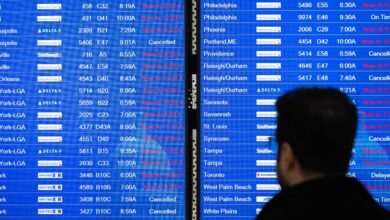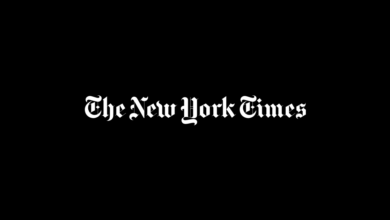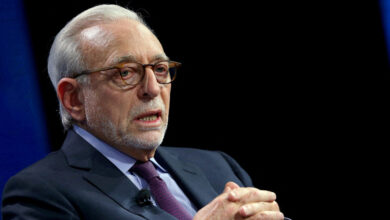What Trump 2.0 Could Mean for the Federal Reserve

Former President Donald J. Trump relentlessly criticized the Federal Reserve and Jerome H. Powell, its chair, during his time in office. As he competes with President Biden for a second presidential term, that history has many on Wall Street wondering: What would a Trump victory mean for America’s central bank?
The Trump campaign does not have detailed plans for the Fed yet, several people in its orbit said, but outside advisers have been more focused on the central bank and have been making suggestions — some minor, others extreme.
While some in Mr. Trump’s circles have floated the idea of trying to limit the Fed’s ability to set interest rates independent of the White House, others have pushed back hard on that idea, and people close to the campaign said they thought such a drastic effort was unlikely. Curbing the central bank’s ability to set interest rates without direct White House influence would be legally and politically tricky, and tinkering with the Fed so overtly could roil the very stock markets that Mr. Trump has frequently used as a yardstick for his success.
But other aspects of Fed policy could end up squarely in Mr. Trump’s sights, both former administration officials and conservative policy thinkers have indicated.
Mr. Trump is poised to once again use public criticism to try to pressure the Fed. If elected, he would also have a chance to appoint a new Fed chair in 2026, and he has already made it clear in public comments that he plans to replace Mr. Powell, whom he elevated to the job before President Biden reappointed him.
“There will be a lot of rhetorical devices thrown at the Fed,” predicted Joseph A. LaVorgna, the chief economist at SMBC Nikko Securities America, an informal adviser to the Trump campaign and the chief economist of the National Economic Council during Mr. Trump’s administration.
And some in Mr. Trump’s circles are urging the campaign to consider more substantial — even institution-altering — changes to the central bank. The Fed regulates the nation’s largest banks, and Mr. Trump could take steps that would give him more control over that process, ultimately making the rules less onerous for financial institutions, for instance.
Here is how the Fed interacts with the White House today and how that could change.
The Fed is independent of the White House.
The Fed is responsible for keeping inflation under control, which it does by using higher interest rates to slow demand and take pressure off prices. Incumbent presidents essentially always prefer low interest rates, which encourage people to borrow and help to bolster the economy, but they have no say in Fed policy.
Independence exists for an important reason: High interest rates can cause near-term economic pain and have cost presidents re-election. But they are sometimes necessary to make sure that inflation remains under control. Research suggests that enabling central bankers to set policy based on the nation’s economic needs rather than a politician’s electoral ones allows policymakers to make better choices.
Since the 1990s, White House administrations have mostly avoided talking about Fed policy out of respect for independence. But Mr. Trump upended that while in office, regularly criticizing the Fed for keeping interest rates too high — suggesting that Mr. Powell was an “enemy” and that the chair and his colleagues were “boneheads.”
That seems destined to continue if Mr. Trump is elected. He has already suggested that any attempt to lower interest rates before the election would be a political ploy to help incumbent Democrats. He made similar comments in the run-up to the 2016 election, then switched to calling for lower interest rates once in office.
Direct efforts to control interest rates could be tough.
As president, Mr. Trump learned that chastising the Fed did little to change policy — officials privately chafed at his commentary, but publicly ignored it, lowering rates by less than what Mr. Trump wanted.
The big question is whether Mr. Trump could go further this time and try to directly control Fed policy.
The Trump campaign website talks about bringing independent agencies under presidential control (promising to put “unelected bureaucrats back in their place”), but is silent on whether that includes the Fed.
Legal experts said it could be difficult for the White House to wrestle Fed interest rate policy under its control without passing legislation through Congress. That was a reality that Russell T. Vought, who ran the Office of Management and Budget in the Trump White House, alluded to during an interview with The New York Times in July.
Firing Mr. Powell could also be tricky.
A White House can influence monetary policy without doing it so directly, though — including through leadership appointments.
The president has a chance to nominate governors to the Fed’s Washington-based board as they leave or as their terms expire. Those officials make up seven of the 12 votes on interest rate policy, and the Fed’s chair, vice chair and vice chair for banking supervision are all White House-nominated governors.
Those roles are all full for now, with only two governorships expiring before the end of 2028. And Mr. Powell’s term as chair does not end until 2026. But Mr. Trump has previously contemplated firing the Fed chair, raising the question of whether he could do so again.
In early 2018, Mr. Trump found himself displeased with Mr. Powell’s lack of loyalty and looked into the possibility of firing the chair before determining that it would be legally fraught. In 2020, he floated the idea of removing Mr. Powell as chair and simply leaving him as one of the Fed’s seven governors, but he never actually tried it.
While some people close to the campaign think that firing Mr. Powell could be on the table again, others have warned that doing so would be legally untried and open to a court challenge. Besides, Mr. LaVorgna noted, Mr. Trump could heap blame on the Fed chair if inflation remained sticky.
“Aside from the legal issues, there’s no incentive to replace the chair,” Mr. LaVorgna said.
Mr. Trump could still use nominations to sway the Fed.
But Mr. Trump has been clear that he has no intention of reappointing Mr. Powell when his term ends.
Mr. Trump would not be able to appoint just anyone as Mr. Powell’s replacement: Nominees for Fed governor and leadership positions must clear Senate confirmation. Mr. Trump tried (or contemplated) appointing Fed governors who had expressed loyalty to him during his first term, including Judy Shelton, Herman Cain and Stephen Moore. None made it onto the Fed, in part because some senators stood by the idea that the Fed should be independent.
The potential Fed chair names circulating this time around are largely conventional picks with economic backgrounds and government experience.
Kevin Warsh, a Stanford professor and former Fed governor; Kevin Hassett, a former chairman of the Council of Economic Advisers; and Christopher Waller, a current Fed governor, are all mentioned as potential candidates. But it is early days, decisions remain far away and several people pointed out that the campaign is not paying much attention to the Fed at this point.
Banking regulation changes could be on the table.
There is a notable exception: Fed bank regulation does seem firmly in focus. Mr. Vought, in his interview with The Times last year, said that “at the bare minimum,” the Fed’s regulatory functions should be subject to White House review.
And Mr. Trump himself seems to refer to plans to defang Fed regulation in a video on his campaign website.
In it, he promises to sign a law to “ban bureaucrats” from punishing companies for violating rules that they have established through informal guidance. That is something that the Fed does to banks through its day-to-day supervision process, and it is a practice that Randal Quarles, Mr. Trump’s vice chair for banking supervision, tried to push back on.
More recently, Republicans have taken issue with the Fed’s supervisory climate stress scenarios, which test to make sure that banks are taking risks like rising sea levels and weather-related insurance payouts into account. Critics fret that they could make it harder and more expensive for oil and gas companies to get financing (something progressive activists have pushed for).
Mr. Trump appeared to allude to that in his video, though he did not mention the Fed by name.
“Never again will bureaucrats be allowed to bully and pressure banks to choke off, financially deplatform, politically disfavored industries,” Mr. Trump said in the clip.
And Republicans are increasingly raising the possibility that Fed independence should not extend to bank regulation — or the person who leads it.
Christina Parajon Skinner, a legal expert in central banking at the University of Pennsylvania, has recently begun to argue that the Fed’s vice chair for supervision could legally be removed by a president because the role is structured differently from the Fed chair’s.
Michael Barr, the Fed’s vice chair for banking supervision, will see his leadership term lapse in 2026. If Ms. Skinner is right, it would be possible to replace him earlier.
She said that while she disagreed “with some of the speculation” that Mr. Trump would want to curtail the Fed’s monetary independence, she did think that “financial regulation is something that the administration would be interested in pivoting” if Mr. Trump would win.
Jonathan Swan contributed reporting.



